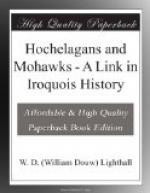In 1608, according to Ferland[12] based evidently upon the statement of Champlain, the remnant of the Hochelagans left in Canada occupied the triangle above Montreal now bounded by Vandreuil, Kingston and Ottawa. This perhaps indicates it as the upper part of their former territory. Sanson’s map places them at about the same part of the Ottawa in the middle of the seventeenth century and identifies them with La Petite Nation, giving them as “Onontcharonons ou La Petite Nation”. That remnant accompanied Champlain against the Iroquois, being of course under the influence of their masters the Hurons and Algonquins. Doubtless their blood is presently represented among the Huron and Algonquin mission Indians of Oka, Lorette, Petite Nation, etc., and perhaps among those of Caughnawaga and to some extent, greater or less, among the Six Nations proper.
From the foregoing outline of their history, it does not appear as if the Hochelagans were exactly the Mohawks proper. It seems more likely that by 1560, settlements, at first mere fishing-parties, then fishing-villages, and later more developed strongholds with agriculture, had already been made on Lake Champlain by independent offshoots of the Hochelagan communities, of perhaps some generations standing, and not unlikely by arrangement with the Algonquins of the Lake similar to the understanding on the river St. Lawrence, as peace and travel appear to have existed there. The bonds of confederacy between village and village were always shifting and loose among these races until the Great League. To their Lake Champlain cousins the Hochelagans would naturally fly for refuge in the day of defeat, for there was no other direction suitable for their retreat. The Hurons and Algonquins carried on the war against the fused peoples, down into Lake Champlain. When, after more than fifty years of the struggle, Champlain goes down to that Lake in 1609, he finds there the clearings from which they have been driven, and marks their cabins on his map of the southeast shore. This testimony is confirmed by that of archaeology showing their movement at the same period into the Mohawk Valley. Doubtless their grandchildren among the Iroquois, like their grandchildren among the Algonquins, remembered perfectly well the fact of their Huron and Algonquin wrongs, and led many a war party back to scenes known to them through tradition, and which it was their ambition to recover. It seems then to be the fact that the Mohawks proper, or some of their villages, while perhaps not exactly Hochelagans, were part of the kindred peoples recently sprung from and dominated by them and were driven out at the same time. The two peoples—Mohawks and Iroquets—had no great time before, if not at the time of Cartier’s arrival—been one race living together in the St. Lawrence valley: In the territory just west of the Mohawk valley, they found the “Senecas” as the Onondagas, Cayugas and Senecas together were




